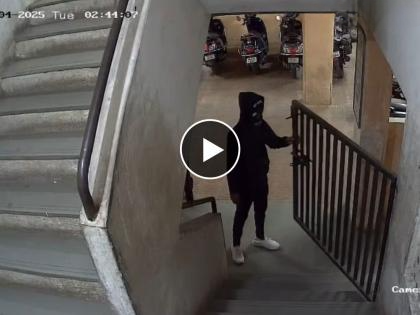Armed intruder: In a chilling and audacious attack that has shaken the very foundation of Pune’s urban safety, a gang of three masked, armed men stormed the Sidra Garden Cooperative Housing Society in Dhanori during the early hours of April 8, 2025. The incident, which unfolded between 4:30 and 5:00 a.m., has become one of the most talked-about crime stories in India this week, sparking widespread fear, outrage, and demands for immediate police action.
The intruders, dressed in black and wielding sickle-shaped knives known locally as koytas, entered the society premises with calculated precision, attempting to break into a flat and terrorize residents. CCTV footage captured their suspicious movements, revealing a meticulously planned operation that has raised serious questions about security lapses and law enforcement preparedness in Pune’s bustling Dhanori neighborhood.
This incident has rapidly gained traction on social media, with residents, security experts, and political leaders condemning the attack and calling for urgent measures to prevent such terrifying episodes from recurring. The residents have lodged a formal complaint with Vishrantwadi Police Station, describing the intruders as “life-threatening and deeply disturbing,” and demanding swift arrests and enhanced security protocols. The police, meanwhile, are reviewing CCTV footage, collecting forensic evidence, and conducting a manhunt to identify and apprehend the culprits. The incident has also ignited a broader debate about rising organized crime, the efficacy of urban security systems, and the need for community vigilance in Pune and across India.
Armed Men Storm Dhanori Housing Society: A Crime of a New Age or a Sign of Growing Threats?
The incident at Sidra Garden is being widely compared to scenes from popular crime thrillers like Money Heist due to the masked, armed intruders and their coordinated movements within the society. CCTV footage shows three men moving suspiciously through the premises, trying to force open a flat door, and intimidating residents with their weapons. Although they did not succeed in stealing anything, their actions have left residents in shock and fear, with many questioning how such a brazen attack was possible in a relatively safe neighborhood.
Residents have expressed their outrage over the security lapses that allowed such a daring operation to take place. Advocate Jatin Adhav, Chairman of the society, has demanded immediate police action, including registration of an FIR, review of CCTV footage, and increased patrolling. “This is a wake-up call for Pune’s urban safety infrastructure,” he said, emphasizing that the incident reflects a disturbing trend of organized, masked robberies and violence that are becoming increasingly sophisticated. The police are now under pressure to enhance surveillance, deploy more patrols, and utilize technological tools like facial recognition and AI monitoring to combat this rising menace.
The incident also raises questions about the growing prevalence of koyta-wielding criminals in Pune, a city that has historically been considered relatively safe. Experts warn that such attacks could be part of organized gangs involved in burglaries, extortion, and even targeted violence. The police have launched special operations to crack down on these groups, but residents remain anxious and demand more proactive measures. The community’s resilience and vigilance will be crucial in overcoming this crisis and restoring a sense of security.
Rising Pattern of Masked Robberies in Pune: A Threat to Urban Safety
The Dhanori attack is not an isolated event but part of a disturbing trend of masked, armed robberies across Pune. Over the past few months, multiple housing societies and residential complexes have reported similar incidents involving masked men brandishing weapons like koytas and machetes. These criminals often operate in coordinated groups, targeting vulnerable neighborhoods during early morning or late-night hours, and leaving residents terrified.
Security experts warn that these incidents point to the emergence of organized gangs that are increasingly bold and violent. The use of masks, weapons, and stealth tactics suggests a well-planned operation, possibly linked to larger criminal networks involved in extortion, kidnapping, or even inter-gang rivalries. The Pune police have responded by intensifying patrols and conducting raids, but residents are demanding smarter, technology-driven solutions such as CCTV surveillance, facial recognition, and community policing initiatives.
The rising frequency of such incidents has also prompted civic authorities to revisit urban security policies, improve street lighting, and promote neighborhood watch programs. Citizens are urging the government to adopt a multi-layered approach that combines technology, community engagement, and stronger law enforcement to effectively combat this growing threat.

Community and Law Enforcement: Struggling to Contain the Fear and Restore Safety
The attack at Dhanori’s Sidra Garden has deeply shaken the community, especially the high number of senior citizens living in the society. Residents have expressed their fears and frustrations, demanding immediate action from law enforcement agencies. Many have invested in private security and CCTV upgrades, but they emphasize that safety cannot be solely dependent on individual efforts.
Advocate Jatin Adhav has called for increased night patrolling, quick response teams, and visible police presence in and around the society. “This incident is not just about our society; it’s about the safety of the entire neighborhood,” he said. The police have assured residents that they are actively investigating, reviewing CCTV footage, and deploying additional personnel to strengthen security. However, residents remain skeptical about the pace of action, especially since the FIR was reportedly delayed or not registered promptly.
The incident at Dhanori has ignited a wider conversation about the state of urban safety across Indian cities, bringing to light critical gaps in existing security frameworks. As metropolitan areas continue to expand rapidly, the challenges of ensuring the safety of residents have grown exponentially. This event underscores the urgent need for comprehensive reforms that go beyond traditional policing methods. Experts advocate for the integration of advanced technological solutions such as AI-powered surveillance systems, facial recognition, and real-time monitoring to detect and prevent criminal activities more effectively. Additionally, upgrading infrastructure like street lighting, emergency response mechanisms, and community alert systems are essential components of a modern urban safety strategy.
Beyond technology and infrastructure, the incident highlights the indispensable role of community participation in crime prevention. Neighborhood vigilance, timely reporting of suspicious activities, and collaborative efforts between residents and law enforcement can create a formidable defense against such threats. Experts caution that without decisive and coordinated action from authorities, incidents like the Dhanori armed intrusion could become alarmingly frequent, leading to a significant erosion of public trust in law enforcement agencies. This growing insecurity not only endangers lives but also affects the overall quality of life, economic development, and social cohesion in urban areas. Therefore, a multi-pronged approach involving policy reforms, technological innovation, and active citizen engagement is crucial to restore confidence and ensure safer cities for all.
The Road Ahead: Strengthening Pune’s Security Framework Against Organized Crime
As Pune grapples with this alarming incident, authorities are under immense pressure to overhaul their security infrastructure. The Pune Police Department has announced plans to increase patrolling, install more CCTV cameras, and employ AI-based monitoring systems in vulnerable neighborhoods. Community policing initiatives are also being promoted to foster trust and cooperation between residents and law enforcement.
The government is considering deploying specialized anti-crime units trained to handle masked, armed gangs, and establishing rapid response teams that can reach crime scenes within minutes. The incident at Dhanori has also prompted discussions about stricter laws and harsher punishments for organized criminals involved in such brazen attacks.
Meanwhile, residents are urged to remain vigilant, report suspicious activities promptly, and participate in neighborhood watch programs. The incident serves as a stark reminder that urban safety is a shared responsibility, and collective efforts are essential to prevent future tragedies.

Conclusion: A Critical Wake-Up Call for Pune and India
The armed intrusion at Dhanori’s Sidra Garden Society marks a dark chapter in Pune’s urban safety history. While police investigations are underway, the incident exposes vulnerabilities in security systems and community preparedness. It underscores the urgent need for technological upgrades, community engagement, and stronger law enforcement to combat organized crime.
The alarming incident in Dhanori has catalyzed a wider debate about urban safety in Indian cities, underscoring the urgent need for comprehensive security reforms and smarter urban planning. Experts and urban planners emphasize that piecemeal efforts are no longer sufficient; instead, cities like Pune must adopt holistic strategies that integrate advanced technology, better infrastructure, and community-driven vigilance. Initiatives such as tactical urbanism—where temporary, low-cost interventions like redesigned intersections and improved pedestrian spaces are tested before permanent implementation—have already shown positive results in cities including Pune and Mumbai. These measures have not only reduced accident rates but also fostered a greater sense of safety among residents by prioritizing pedestrian and community needs in urban design.
However, experts warn that unless authorities act decisively and consistently, such terrifying incidents could become more frequent, eroding public confidence and putting more lives at risk. The push for safer cities now includes calls for the implementation of comprehensive pedestrian safety plans, enhanced surveillance, and the use of smart city technologies for real-time monitoring and rapid response. Community engagement remains a cornerstone of these efforts, as collaborative vigilance between citizens, civic bodies, and law enforcement can significantly strengthen urban resilience. Ultimately, only through a combination of technological innovation, policy reforms, and active public participation can Indian cities hope to prevent future episodes of violence and restore a lasting sense of security among their residents.
Follow: Channel 6 Network

